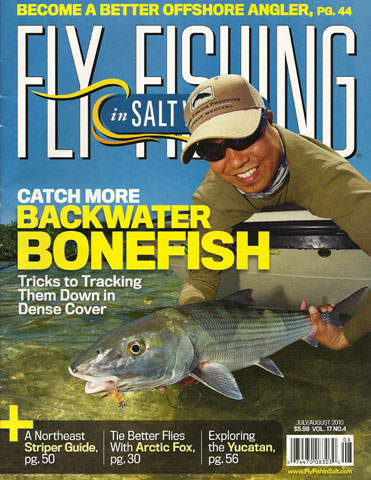Migratory fish get under your skin. They follow a lot of rules, but they break almost as many as they follow.
That makes them a lot like an outstanding novel, with a beginning, a peak and an end. The story line comes together on a beach in the fall. Fishing conditions improve considerably, peak and then gradually wind down. Anglers study tides, lunar cycles, wind and water temperatures to determine patterns. When something doesn’t add up, they play hunches and take educated guesses.
In the Northeast, the fall usually means striped bass and blues on the beach. But from Chatham, Massachusetts, and westward, the Gulf Stream pushes close to land. From July through October, you’ll find false albacore, green bonito and skipjack. The fall run is addictive. Sometimes you’ll find peace in your fishing. Other times the fish will drive you just plain nuts.
Weather and Moon
The fall run has been the subject of fishing lore for decades. From the 1940s to 1960s, the Cape Cod beaches were the places to be, period. From Nauset Beach in Orleans through Race Point in Provincetown, 40-pound bass were considered rats. Four-by-four campers with tin skiffs strapped atop them brought anglers who fished around the clock from shore or from beach launched skiffs.
This continues today, and hard-core anglers from Maine through New Jersey head to the beaches to get in their last licks of the season. Technically, the autumnal equinox, around Sept. 21, is when daytime and nighttime are nearly identical in length. In the fall, days grow steadily shorter, whereas they grow steadily longer in the spring. Sunsets come earlier, and fall winds shift from southerly to Canadian Maritime northerly. Cool, dry air with high cloud ceilings and mare’s-tail formations reflect the strong winds, and there is a greater difference between daytime and nighttime temperatures. Sunrise and sunset colors change too, from oranges and yellows to more purples, greens and blues.
Figuratively, fall begins with the “Striper moon,” or the first full moon in September. Kenny Abrames dubbed this time frame, as it represents the first major push of the striped bass migration. During some years, the striper moon is early in the month; other years, it is later. Regardless it is a great time to get out and fish. In New England, the biggest shore-caught bass of the year are landed around the striper moon.
October’s Indian summer, though, is a pleasant respite from September’s initial cold weather. It’s when the fall feels like summer. History alleges that the two-week warm spell was when American Indians harvested the bulk of their crops, hence the name. Most of the pelagic fish will follow the retracting Gulf Stream south at this time, so the end of Indian summer usually marks their departure.
Learn to Read the Birds
As in so many other fisheries, birds are hugely important to the fall run. But they don’t just indicate the presence of fish and angling opportunity—rather, they can tell an angler what kind of bait is in the water.
Terns hit small baits, mostly silversides, bay anchovies and sand eels. When they hover close to the water’s surface, they’re on a big pod of bait with predators underneath. If they’re winging it high, they’re looking for food. If they fly fast right above the surface, albies or bonito are probably in the mix (as opposed to the slower striped bass and bluefish).
Most gulls are scavengers, but they too can tell you what kind of bait is around. Herring gulls feed on herring, but they also love mackerel. When a flock of herring gulls works together, there is probably a school of big bass underneath the bait. Black-backed gulls are the most aggressive and basically eat anything smaller than them. Their value to anglers is similar to that of black-headed laughing gulls, as they love crustaceans, particularly crabs.
Shearwaters feast on squid but also follow schools of mackerel and menhaden. The Cory’s and the sooty are two popular shearwaters in the Northeast. Storm petrels, meanwhile, are skimmer birds that tiptoe their way across the water’s surface in search of plankton. Petrels follow bigger bait like the squid and mackerel that feed on the silversides and the anchovies that feed on the plankton. Petrels and stripers love shrimp.
Gannets are plunge divers that soar 50 to 70 feet high. When they get a clear view of their favorite food, herring, they crash into the water, with air sacs cushioning their impact. Gannets use their wings to swim to bait, which they either inhale or impale with their long, pointed beaks. When you see a flock of them diving along a beach, you’re in for a treat.
Sea ducks are common in the fall. Mergansers feed on small baitfish like silversides, sand eels and shrimp. Common eiders like small bait as well, and king eiders like squid. The oldsquaw feast on shrimp, while surf scoters target crabs. Diver ducks like tide lines and frequent Oceanside beaches with good current and tide seams, but they’ll move into the bays and estuaries with the bass and blues.
Belly Up to the Bar
Northeast beaches in the fall are ripe with bait that stages and then pushes on the various moons. If you’re in the wrong place at the wrong time, you’ll miss the silversides, sand eels, glass minnows, herrings, peanut bunker, anchovies, mullets and butterfish that head south for the winter.
Find the bait, and you’ll find the fish. Bait stages in coves during half-moons and moves on full moons, so you’ll want to fish points of bars on the full and new moons and coves on the quarter moons. If you go to an area and see a lot of bait but no fish, then switch spots. I guarantee that the fish found more bait somewhere else! The schools of fish move into either the wind or the tide, whichever is stronger, so you should pick your next spot with that in mind.
When you arrive at a beach at low tide, preferably at a negative tide, you’ll be able to see the terrain that will set you up for the moving water and an approach.
Onshore bars connect to shore. They typically run at an angle based on the dominant current. Start fishing at the drop, and work your way out to the point. As the tide begins to flood, fish your way back to shore. Fish the point and both sides, and watch the bowl along the leeward side, where the bar joins land. Bait and fish will gather in that bowl and move over the bar when the water is high enough.
Bull-nose bars are rounded and look like an upside-down letter U. Sometimes fish hold in the lee; other times they feast on the windward side. Watch the way the current moves over the bar, and cast your fly up and across, letting it swing into the adjoining deeper water. When the fish are tight to the beach, you won’t have to cast very far.
Parallel offshore bars are not connected to land and have hard-running currents blowing through on all sides. At low tide, they may be exposed or just slightly underwater. An easy way to find a parallel offshore bar is to look for a “tribe.” Surfers love a good beach break! Sometimes the back bowl between the beach and the bar is chockablock with bass. Other times the fish are on the outside edge. And still other times they’re working the currents on either end. You can wade to some offshore bars on the low tide, but wear a Farmer John wetsuit. As the tide comes up, you can float back to shore.
Points are spits of sand that jut out into the ocean, while bowls, or holes, are basins that have deeper water and lots of current.
Use ranges to mark mother lodes. Take a longitudinal point and match it with a latitudinal point, and X marks the spot. The right end of a cottage porch and a lobster buoy could be a coordinate in its simplest form. Other common structures are water towers, buoys, breakwaters, channel markers, rock piles and trees.
Northern New England and Massachusetts Bay
From August to mid-October, Dave Gibson, of Great Bay Rod Co., fishes beaches in the fall from Maine through northern Massachusetts. He doesn’t see lots of birds marking fish in Maine and New Hampshire, but instead he drives along Route 1A looking for beachfronts that are sandwiched between the rocky coastline.
He typically searches for those spots around low tide and returns to fish them during the last few hours of the food through the first few hours of the drop. Because of the cold water, he likes Monic intermediate lines and adds a variety of lengths of lead-core lines for additional depth.
Running the beach at Plum Island,Massachusetts, is the easiest way to find fish. Because of the usually present sand eels, Gibson sees more bird activity there. Still, he’ll tie longer flies because of the diverse baitfish that dump out of the river systems.
In Massachusetts Bay from September to October, schools of striped bass split, with some migrating on the inside of the bay. With all of the river systems from the North Shore down through the South Shore, there is never a shortage of baitfish dropping out. The last beach on the South Shore is White Horse Beach, and it is just north of Cape Cod Canal, where all the bayside fish push through.
Cape God and Rhode lsland
In September and November, other fish follow the Labrador Current, which runs from Plum Island to Cape Cod’s Race Point. According to Capt. Dave Steeves, of Fishing the Cape, the fish seem to split.
“Race Point, in Provincetown, has historically been an exceptional spot,” he says. “Some of the fish will move along the bay side, and Sandy Point, on the outside of Barnstable Harbor, is excellent. We also find bass and blues along the outer beaches in Truro, Wellfeet, Eastham andOrleans. Reverse the spring patterns, and you’ll find them.”
Fishing the Cape owner Bruce Zeller reports that the number of bass on the Oceanside beaches is smaller, but the quality is outstanding. “This past year we saw a tremendous amount of bait right up on shore, and long casts weren’t necessary,” he says. ” As the water cools down, we change fly lines and favor the Cortland PE+ Crystal and the Airflo Cold Saltwater fly lines because they don’t kink up.”
Anglers consider Rhode Island, the Ocean State, the smallest state with the longest run. “As the migration starts, you’ll find fish dropping down from Upper Narragansett Bay,” says Peter Jenkins, owner of the Saltwater Edge in Middletown. “While most anglers think of fishing the beaches of South County, the Upper Bay beaches are great places to start to fish.”
As the fish drop down from Upper Narragansett Bay, the Saltwater Edge’s general manager, Arden Gardell, says he “finds fish spreading throughout Newport’s First, Second and Third beaches, from the cobble beaches around Narragansett down through the rocky and sandy Scarborough Beach and throughout South County. From the sandy Matunuck to the rocky Carpenters Bar to the expansive Charlestown Beach, Weekapaug and Napatree Point, you’ll find the bass and blues throughout all of the stages of the run.”
There’s always something to be found during the Northeast’s fall run. While the addictive quest can indeed drive you nuts at times, there’s plenty of peace to be found in this fishing.

